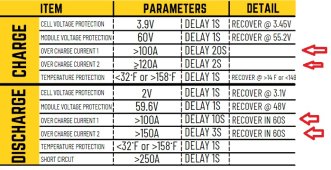FilterGuy
Solar Engineering Consultant - EG4 and Consumers
I am seeing posts of people wanting to build 48V systems with 5 or 6KW inverters and server rack batteries. This is a nice, clean way to build a system, but be aware of the current limits on a lot of the server rack batteries.
I just saw this for the Pylontec batteries:

A 5000W inverter at 90% efficiency can draw as much as 116A, so a proper system would need 5 of the US2000C batteries.
The LiFePOWER4 is a lot better:

But you would still need 2 of them to properly provision a 5K inverter.
I have seen other batteries with surprisingly low current limits. My main point is: Be aware of the battery limits and make sure the battery bank meets the needs of the inverter.
I just saw this for the Pylontec batteries:

A 5000W inverter at 90% efficiency can draw as much as 116A, so a proper system would need 5 of the US2000C batteries.
The LiFePOWER4 is a lot better:

But you would still need 2 of them to properly provision a 5K inverter.
I have seen other batteries with surprisingly low current limits. My main point is: Be aware of the battery limits and make sure the battery bank meets the needs of the inverter.





